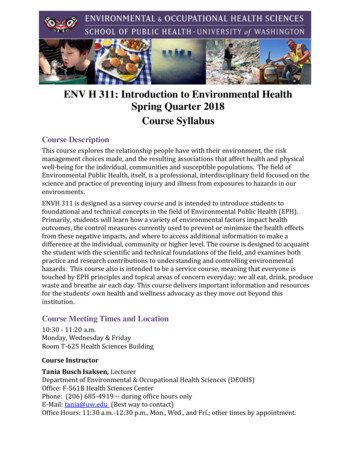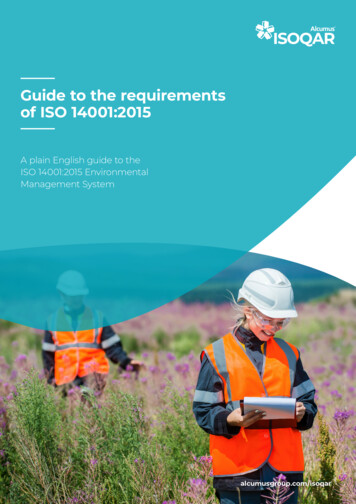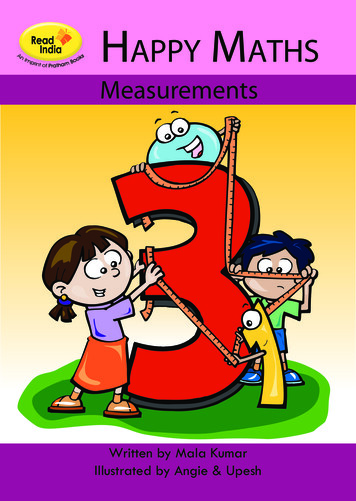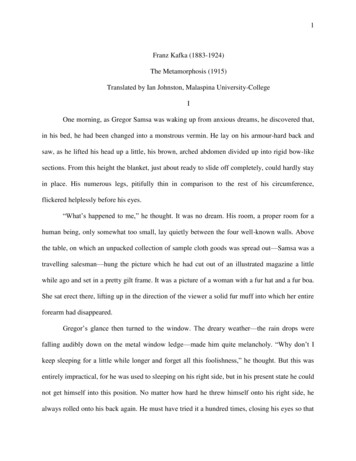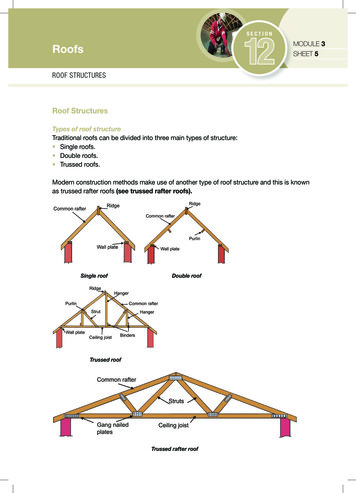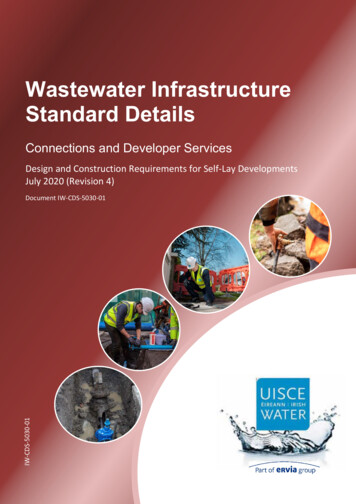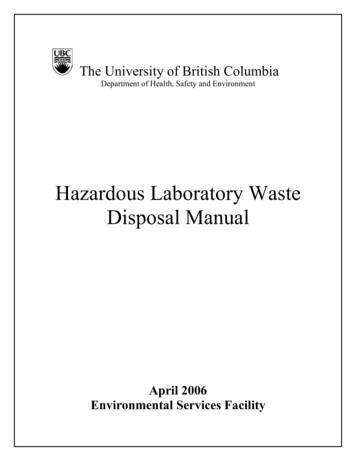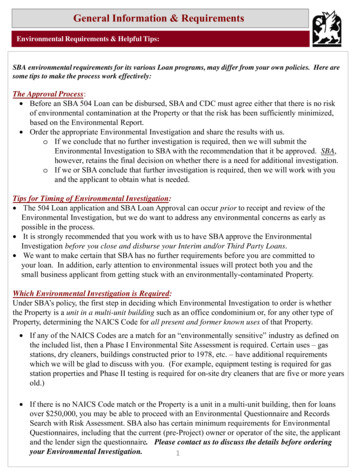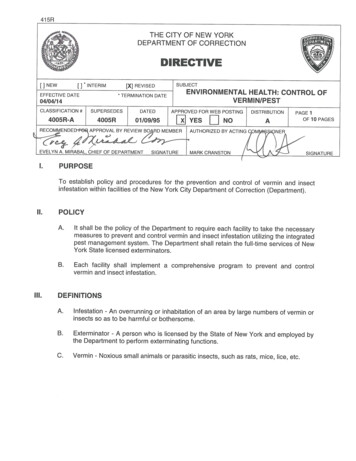
Transcription
416REFFECTIVE DATE04/04/14CLASSIFICATION #4005R-ADISTRIBUTIONAIV.SUBJECTENVIRONMENTAL HEALTH: CONTROL OFVERMIN/PESTAPPROVED FOR WEB POSTINGX YESNOPAGE2 OF10 PAGESPROCEDUREA.Integrated Pest Management ProgramThe Integrated Pest Management (IPM) Program is a three pronged approach tovermin/pest control. The program components are sanitation, vermin proofing, andthe use of traps and the most target specific, least toxic pesticides to control andprevent vermin and pest activity. An effective sanitation program decreases the foodsupply and provision of shelter necessary for the habitation of vermin and pests.Vermin proofing consists of “building out” vermin and pests thereby preventingaccess into the facility. The identification and remediation of vermin entry points,including, but not limited to, missing and torn screens, missing drain covers, holes,gaps and separations along the floor, wall and ceiling, and missing door sweeps isessential to a successful IPM program. All staff members shall generate work ordersto abate these conditions. Utilization of traps and the least toxic, most target specificpesticides is the final component of the program.B.Duties and Responsibilities1.Commanding Officers shall ensure:a.All areas of the facility are clean and free of vermin entry points;b.All vermin related deficiencies cited on the public health sanitarian reportsand other regulatory agency and oversight agency reports are abatedexpeditiously;c.All schedules and inspections detailed in this directive are adhered to;d.Adequate staffing is provided for all vermin/pest related tasks;e.All garbage, refuse, and recyclables are stored in tightly securedcontainers;f.The foliage and lawn are well maintained to prevent harborage andnesting conditions;g.The Deputy Warden for Administration, Tour Commander, EnvironmentalHealth Captain (EHO), and the area captains perform thoroughinspections during their tours of duty and ensure that deficiencies areabated expeditiously; and
416REFFECTIVE DATE04/04/14CLASSIFICATION #4005R-ADISTRIBUTIONAIV.SUBJECTENVIRONMENTAL HEALTH: CONTROL OFVERMIN/PESTAPPROVED FOR WEB POSTINGX YESNOPAGE3 OF10 PAGESPROCEDURE (cont.)h.2.3.The New York State Department ofEnvironmental ConservationApplicator/Technician Pesticide Annual Report (Attachment A) and theNew York City Applicator/Technician Additional Reporting Data(Attachment B) generated each month are forwarded to the AssistantCommissioner for Environmental Health on the first day of the followingmonth.Deputy Warden for Administration shall ensure:a.Housekeeping procedures outlined in Directive #3901R-B, HousekeepingProcedures are adhered to throughout the facility and that sufficient staffmembers are assigned to sanitation details to clean the common areas ofthe facility;b.Adequate staffing is provided for the abatement of any vermin entrypoints;c.Area captains conduct thorough inspections and identify all vermin entrypoints, and signs of vermin activity including, but not limited to, animaldroppings, rub marks, construction of nesting materials, and watersources;d.All reports listed in Section (IV)(.B.)(6.)(c).below are completed by theexterminator and are submitted to the warden and the assistantcommissioner for environmental health as directed; ande.A suitable number of commissary buckets with tight fitting lids areavailable to provide at least one commissary bucket to each inmate.Environmental Health Officer (EHO) shall ensure:a.The mandated weekly inspection of the facility occurs in a timely fashionand notes any signs of vermin/pest infestation, any vermin entry points,water sources, and any other conditions conducive to harborage.Conditions conducive to harborage include, but are not limited to, storingunused equipments, stock piling of garbage or other waste, provision ofnesting materials. If the EHO inspection reveals an infestation, the EHOwill immediately contact the exterminator assigned to the facility and orderthe exterminator to exterminate the area in question immediately. If thefacility exterminator is not available, the EHO shall contact the Deputy
416REFFECTIVE DATE04/04/14CLASSIFICATION #4005R-ADISTRIBUTIONAIV.SUBJECTENVIRONMENTAL HEALTH: CONTROL OFVERMIN/PESTAPPROVED FOR WEB POSTINGX YESPAGENO4 OF10 PAGESPROCEDURE (cont.)Executive Director for Environmental Health to request an exterminatorfrom another facility.Note: The facility exterminator performs inspections as detailed in section(IV)(B)(6).b.4.5.Ensure that grass and/or foliage are removed from grounds adjacent tothe facility by the Special Operations Division or facility, when the EHO isadvised by the exterminator that grass/foliage removal must beperformed.Area Captains shall ensure:a.A that a thorough inspection is conducted in each area of supervision. Thearea captain shall document all vermin/pest related deficiencies noted inthe area logbook. The captain shall conduct a second inspection duringtheir tour to ensure that all sanitation deficiencies were abated, work orderswere generated for all vermin entry points and plumbing deficiencies, andthat all food is properly stored.b.The exterminator is notified of any vermin infestation noted in his/her areaof supervision.c.All Correction Officers and inmates are instructed on conditions conducive tovermin activity including, but not limited to, poor sanitation, improperly storedfood, damaging window screens, and creating cracks/crevices/holes thatallow vermin entry.d.The EHO is notified of any infestation in their area of supervision.Supervisor of Mechanics shall ensure:a.All plumbing leaks are abated expeditiously.b.All vermin access points are sealed, including, but not limited to, gaps,holes, cracks, crevices, etc.c.Door sweeps are installed on all exterior doors.d.Window screens are provided and are in good condition.
416REFFECTIVE DATESUBJECT04/04/14CLASSIFICATION #4005R-ADISTRIBUTIONAPPROVED FOR WEB POSTINGAIV.ENVIRONMENTAL HEALTH: CONTROL OFVERMIN/PESTX YESNOPAGE5 OF10 PAGESPROCEDURE (cont.)6.Exterminator shall ensure:a.The continual inspection of the facility and grounds adjacent to the facility,including, but not limited to, the areas and frequencies specified hereini.Housing areas - monthly;ii.Kitchen/food preparation areas - minimum, once weekly;iii.Commissary - minimum, once weekly;iv.Storehouse - minimum, once weekly;v.Food storage areas - minimum, once weekly;vi.Medical areas - minimum, once weekly to be coordinated with therequirements of the health care provider;vii.General areas within the facility, (i.e., stockrooms, storage areas,crawl spaces, basements, etc.) every two months; andviii.Outside perimeter every two weeks (immediate area surroundingoutside of facility).b.The exterminator assigned to the facility shall canvas staff and inmatesduring his/her inspections to determine if any particular problems ofinfestation are noted by them.c.The exterminator assigned to the facility shall prepare and submit theNYS Department of Environmental Conservation Applicator/TechnicianAnnual Report Form #44-15-26 (Attachment A), the New York CityApplicator/Technician Additional Reporting Data (Attachment B), and form4005R (Attachment C) listing the inspection findings for the month to theEHO and Warden describing the results of his/her inspections and allsuch measures taken to prevent or eradicate vermin and insectinfestation. These reports must be submitted to the AssistantCommissioner of Environmental Health on the first day of each month.d.The exterminator shall continuously evaluate rat, mouse, and insectresistance to a given pesticide.
416REFFECTIVE DATE04/04/14CLASSIFICATION #4005R-ADISTRIBUTIONAIV.SUBJECTENVIRONMENTAL HEALTH: CONTROL OFVERMIN/PESTAPPROVED FOR WEB POSTINGX YESNOPAGE6 OF10 PAGESPROCEDURE (cont.)7.e.The exterminator shall carry caulking material to ensure that allcrack/crevices are sealed during his/her inspection. If the crack/crevice istoo large for the exterminator to seal or additional maintenancedeficiencies conducive to vermin activity are observed, the exterminatorshall submit a work order, note the condition in the exterminator’s report,and inform the supervisor of mechanics of the condition.f.The exterminator shall notify the EHO, if in the exterminator’s professionalopinion determines grass or foliage presents an actual or potentialbreeding or nesting problem.g.The education of staff members and inmates regarding conditionsconducive to vermin activity. The exterminator shall advise staff andinmates that improper storage and storage of unauthorized and excessivefood contributes to infestation of vermin/pests.h.In the facility lobby, the exterminator shall post a list of pesticidescommonly used in the facility. If an exterminator uses a pesticide that isnot commonly utilized in the facility, the exterminator shall post the nameof the pesticide 24 hours in advance of using the pesticide. In the eventthat the exterminator needs to utilize a pesticide in an emergency, theexterminator shall contact the Assistant Commissioner for EnvironmentalHealth for permission.All Members of Service shall:Conduct daily inspections of their area of responsibility as part of their regularduties, to detect evidence of infestation and any conditions conducive to verminactivity. Any discovery of infestation or conditions conducive to vermin activity,such as gaps, holes, missing or torn screens, and plumbing leaks shall beimmediately reported to the area supervisor and a work order shall begenerated. In addition, a logbook entry of the inspection shall be recordedspecifying the results of the inspection and the date notification were initiated tothe area supervisor.
416REFFECTIVE DATE04/04/14CLASSIFICATION #4005R-ADISTRIBUTIONAIV.SUBJECTENVIRONMENTAL HEALTH: CONTROL OFVERMIN/PESTAPPROVED FOR WEB POSTINGX YESNOPAGE7 OF10 PAGESPROCEDURE (cont.)C.Extermination of Vermin/Pest Infestation1.The exterminator assigned to the facility will immediately exterminate all areasof the facility or grounds adjacent to the facility where the presence ofvermin/pests is indicated. The exterminator assigned to the facility will initiatean eradication program that will target the identified rodents or insects and theirindividual attributes. The eradication program will not cease until the vermin orinsect infestation has been eliminated.2.In the absence of any evidence related to the infestation of vermin/pests,chemical rodenticides/insecticides shall not be used in a preventive manner.3.The exterminator shall take proper precautions and follow manufacturers’instructions when using all insecticides, rodenticides, traps, and other materialsfor the control of vermin and insects, to prevent food contamination, firehazards and injury or illness to staff and inmates.4.The facility exterminator shall ensure that only U.S. E.P.A. registeredrodenticides, insecticides and pesticides approved by Local Law 37 areordered and used.NOTE:D.For proper use and storage - see Rule and Regulation #4.05.100.Reporting/Documentation1.The NYS Department of Environmental Conservation CommercialApplicator/Technician Pesticide Annual Report (Attachment A) and the NewYork City Applicator/Technician Pesticide Annual Report (Attachment B) shallbe completed by the exterminator assigned to the facility after completinghis/her assigned inspections. The exterminator shall also complete Vermin andPest Control Monthly Inspection Results Form #4005R listing all areasinspected with findings during the monthly inspection. The reports shall besubmitted to the EHO and the Warden. The original copy of the report shall besubmitted to the commanding officer with copies to:a.The Assistant Commissioner for Environmental HealthEnvironmental Health Unit17-41 Hazen Street, E. Elmhurst, NY 11370b.The Deputy Warden for Administration
416REFFECTIVE DATE04/04/14CLASSIFICATION #4005R-ADISTRIBUTIONSUBJECTENVIRONMENTAL HEALTH: CONTROL OFVERMIN/PESTAPPROVED FOR WEB POSTINGAIV.X YESNOPAGE8 OF10 PAGESPROCEDURE (cont.)c.2.E.Facility fileThe exterminator shall record all inspections and exterminations in the logbookof the area he/she is working in. The logbook entry shall include the following:a.Time entering and leaving areab.Name of exterminatorc.Negative or positive findingsd.Work performedHospital Prison WardsThe Commanding Officer of the Hospital Prison Wards shall ensure that the writtenprocedures for each respective ward coincide with the policy of the respectivehospital.F.Command Level OrderEach facility's Command Level Order concerning the prevention of and control ofvermin/pest infestation shall include procedures for:1.The promulgation of a schedule specifying the continual inspection of thefacility and grounds adjacent to the facility and frequency of inspections to meetor exceed the list of frequencies in section (IV)(B)(6)(a).2.Collecting and removing refuse in the food storage, preparation and serviceareas, including all dayrooms and dining areas where food is served, after eachmeal and more often if necessary to maintain sanitary conditions. All garbagemust be removed from food preparation areas at the completion of foodpreparation.3.The requirement that garbage and refuse must be placed in containers whichare durable, non-porous, water-tight, rust-resistant, inaccessible to insects andvermin, easily cleanable and fitted with fly-tight covers.
416REFFECTIVE DATE04/04/14CLASSIFICATION #4005R-ADISTRIBUTIONAIV.V.VI.SUBJECTENVIRONMENTAL HEALTH: CONTROL OFVERMIN/PESTAPPROVED FOR WEB POSTINGX YESPAGENO9 OF10 PAGESPROCEDURE (cont.)4.Protecting all openings to the outside against the entry of vermin and insects.Close fitting screens that are fly and mosquito tight and free of breaks shall beprovided and maintained on all windows during the seasons when flies andmosquitoes prevail in any area infested by flies or mosquitoes.5.Ensuring that garbage and refuse containers are kept clean and that storageareas are free of spilled food and litter.6.The daily sweeping and mopping of floors, stairs and passageways to removefood particles.7.Eliminating stagnant water. Fill in depressions and drain water to sewer orstreet drain.8.Ensuring that plumbing is kept in good order to prevent leaks.9.Sealing of all openings, cracks and holes in the walls, floors, doors, and aroundpipes and conduits that may allow rats, mice and other vermin access to thebuilding.REFERENCES (In the event that a reference is superseded, the successordocument shall apply.)A.Consent Decree, Benjamin v. Malcolm (75 Civ. 3073 [Mel.])B.Department Rule and Regulation #4.05.100ATTACHMENTSA.NYS Department of Environmental Conservation Applicator/Technician PesticideAnnual Report Form 44-15-26 (10/01)B.New York City Applicator/Technician Additional Reporting DataC.Exterminator Inspection Findings, Form 4005R
416REFFECTIVE DATE04/04/14CLASSIFICATION #4005R-ADISTRIBUTIONSUBJECTENVIRONMENTAL HEALTH: CONTROL OFVERMIN/PESTAPPROVED FOR WEB POSTINGAVII.VIII.X YESNOPAGE10 OF10 PAGESSUPERSEDESA.Directive #4005R entitled, ENVIRONMENTALVERMIN/PEST, dated 01/09/95.HEALTH:CONTROLOFB.Any other Directive, Operations Order, Teletype, Memorandum, etc, that may be inconflict with the policies and procedures outlined herein.SPECIAL INSTRUCTIONSA.Within ten (10) calendar days of the effective date of this order, all CommandingOfficers shall implement a Command Level Order incorporating the policy andprovisions outlined herein.B.All facility managers and supervisors shall ensure strict enforcement of the policy,guidelines and procedures noted herein.
ATTACHMENT CFORM 4005R: EXTERMINATOR INSPECTION FINDINGSFACILITY:DATEAREAMONTH:INSPECTION FINDING (PESTIDENTIFIED, HOLE, OPENING, ETC)ABATEMENT ACTION TAKEN(PESTICIDE USED, TRAPS,MONITORS, WORK ORDERSUBMITTED, ETC)EXTERMINATOR SIGNATURE: DEC LICENSE #:PAGE OF
A. Integrated Pest Management Program The Integrated Pest Management (IPM) Program is a three pronged approach to vermin/pest control. The program components are sanitation, vermin proofing, and the use of traps and the most target specific, least toxic pesticides to control and prevent vermin and pest activity.
